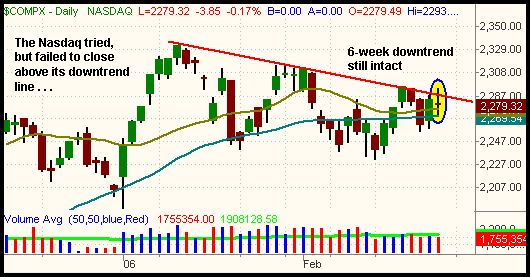Market at a crossroads, here’s my plan
For the second consecutive day, the
S&P 500 tested resistance of its 52-week high and failed, causing
stocks to close lower across the board. Similarly, the Nasdaq Composite
(
COMP |
Quote |
Chart |
News |
PowerRating)
probed above resistance of its daily downtrend line yesterday afternoon, but was
unable to close above it. Although the small-cap Russell 2000
(
RUT |
Quote |
Chart |
News |
PowerRating) and
Nasdaq Composite each showed 0.5% gains at their intraday highs, both indices
finished 0.2% lower. The S&P 500 lost 0.4%, the Dow Jones Industrials 0.6%, and
the mid-cap S&P 400 0.3%.
Total volume in the NYSE fell by 3%, while volume in the
Nasdaq was 4% lighter than the previous day’s level. The decline in turnover was
positive because it indicates institutions were not actively involved in
yesterday’s losses. But the lighter turnover also means that volume in both
exchanges has come in below their respective 50-day average levels every day
this week. If you consider the recent indecisive nature of the market, it is not
surprising that volume levels have been so low. When institutions finally do
take a stance in one direction or the other, we should expect a swift move in
stock prices that will coincide with a volume spike.
The broad market’s price action of the past two days tells us
that the major indices are at a “make it or break it” level, the result of which
would likely determine the stock market’s direction over the next several
months. Most notable is that the S&P 500 has tried to break out to a new 52-week
high in each of the past two sessions, but has been unable to do so. The red
horizontal line on the daily chart below illustrates this pivotal resistance
level:

If the S&P manages to close above the 1,295 level, it will
have broken its January high. Such an occurrence could easily spark an extended,
momentum-driven rally due to the lack of overhead supply. But if the index does
not break out within the next several days, the bulls could “throw in the
towel,” which would also attract short sellers. Failure to break out at this
pivotal 1,295 resistance level would also result in a bearish “double top”
formation. So as you might have guessed, all eyes will certainly be on the S&P
500 over the next few days.
Like the S&P, the Nasdaq Composite also closed just below a
pivotal resistance level. As of yesterday afternoon, the Nasdaq was poised to
close above resistance of its six-week downtrend line, but it sold off in the
final hour of trading. The index finished the session in the middle of its
intraday range, forming a “doji star” candlestick in the process:

Based on its close proximity to the downtrend line and the
first failed attempt at breaking it, we’re certain that traders will be equally
focused on whether or not the Nasdaq can break out. Everything we said about the
direction of the S&P at this pivotal level can be said about the Nasdaq as well.
More than any other time this year, the markets are at a
crossroads. Obviously, it is risky to be making aggressive bets on either side
of the market right now without first getting confirmation of which way the
market wants to go from here. Because of this, we are not looking to enter any
new positions until the market “makes it or break it.” Remaining mostly in cash
will enable us to easily “hop on board” in whichever direction the market goes.
Simply following the trend of the market is always easier and much more
profitable than anticipating direction at a pivotal level. But above all,
remember to trade what you see, not what you think!
Open ETF positions:
Long FXI, short MDY (regular subscribers to
The Wagner Daily
receive detailed stop and target prices on open positions and detailed setup
information on new ETF trade entry prices. Intraday e-mail alerts are also sent
as needed.)
Deron Wagner is the head trader of Morpheus Capital Hedge Fund and founder of
Morpheus Trading Group (morpheustrading.com),
which he launched in 2001. Wagner appears on his best-selling video, Sector
Trading Strategies (Marketplace Books, June 2002), and is co-author of both The
Long-Term Day Trader (Career Press, April 2000) and The After-Hours Trader
(McGraw Hill, August 2000). Past television appearances include CNBC, ABC, and
Yahoo! FinanceVision. He is also a frequent guest speaker at various trading and
financial conferences around the world. For a free trial to the full version of
The Wagner Daily or to learn about Deron’s other services, visit
morpheustrading.com or send an e-mail to
deron@morpheustrading.com .
Â
Â
